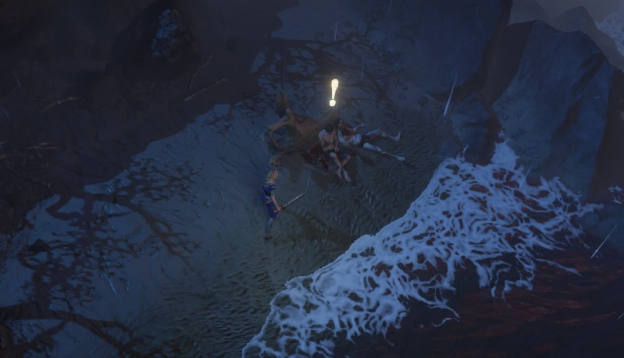Games
PoE 1 vs PoE 2 Comparison


Whenever a new game gains attention, we compare it to similar titles. This article explores the differences and similarities between Path of Exile 1 and Path of Exile 2, including their gameplay, class systems, crafting, end-game activities, and more.
We’ve designed our comparison of Path of Exile 1 vs Path of Exile 2 with a user-friendly structure, ensuring it’s easy to follow and navigate. Now, let’s explore these two games, starting with the gameplay.
PoE 1 vs PoE 2 Gameplay
There are some differences between the gameplay of the two installments. Path of Exile 1 features faster-paced and simple gameplay, while Path of Exile 2 has a more slow-paced and tougher gameplay, similar to Diablo 4. PoE 1 features a faster but relaxed playstyle, sometimes with boring and more repetitive gameplay loops, while PoE 2 has a more engaging and rewarding style but is more challenging for the player.
If you find yourself struggling through the tougher environment of Path of Exile 2, Kboosting offers PoE 2 boosting services that can assist you in obtaining currency, leveling characters, completing builds, and many more end-game activities. Despite the differences, at the core, both games have many similarities in terms of gameplay. They are both action role-play games (ARPGS), which all share the same action-packed, monster-slaying playstyle that keeps the player engaged for long periods.
Gameplay in Path of Exile 2
PoE 2 takes on a slower-paced gameplay, which is more similar to Diablo 4 than the first game, and implements many new mechanics. One of the most important mechanics is the dodge roll, which is available to all classes, has a set cooldown, and does not provide any invulnerability frames for the character during the animation. The dodge roll mechanic favors a slower and more calculated playstyle, which emphasizes dodging enemy attacks and carefully planning encounters, with attacks being more deadly and punishing if you find yourself being caught off-guard.
Another change in Path of Exile 2’s gameplay is the crowd control system. In Path of Exile 1, you had a chance to apply crowd control or debuffs to enemies based on the stats on your passive skill tree and affixes on your items. In PoE 2, there will be a poise system similar to the one in Diablo 4, which adds a progress bar to enemies when hit by a specific type of damage. When the bar fills up completely, the enemy will be afflicted with the respective debuff and gain immunity to crowd control for a short period. The system works the same way when mobs hit the player.
Path of Exile 1 Gameplay
In Path of Exile 1, the gameplay focuses more on fast-paced action. It is unique in the ARPG genre with its action-packed and hectic style. Due to the lack of dodgeball, PoE 1 took a completely different approach to dealing with enemy attacks and abilities. Instead of having fewer challenging encounters that require attention, the first game likes to throw many enemies at you.
Due to the vast amount of enemies, your screen will constantly be filled with effects and projectiles that are close to impossible to dodge, so players resorted to fitting enough defensive stats, skills, and auras in their builds to the point where they can ignore incoming damage without sacrificing too much damage.
Next up, let’s adventure into the campaigns.
PoE 2 vs PoE 1 Campaign
Both games feature a campaign set in the same environment: the world of Wraeclast. Players take the role of Exiles, humans who have been exiled out of Oriath by the Court of Divine Temperance of Theopolis for committing various acts of treason against the empire.
Path of Exile 1 Campaign
Path of Exile 1 features a 10-act-long campaign split into two parts, each having 5 acts. The story starts you off on the beach of Lioneye’s Watch after being exiled from Theopolis. You make your way inland, meeting and helping other exiles along the way.
The PoE 1 campaign is nothing special. It serves as an introduction to the game and creates a streamlined leveling process from level 1 until around 70. Since it’s not skippable, the campaign quickly gets stale after a few characters. It does not have any tough parts since the game’s main aspect is the end game, but it can be time-consuming. The most experienced players can complete it in around 6 hours on a fresh character.
Path of Exile 2 Campaign
In Path of Exile 2, the campaign aims to be shorter in number of acts, having a total of 6 chapters. Each chapter will take you through a different zone, encountering many tribes across Oriath and offering a campaign continuation from the first game. Areas are developed to be more immersive, with items and enemies alike reflecting the zone’s theme in appearance.
This fresh take from Grinding Gear Games will aim to make the campaign feel less stale, with the NPCs being more engaging and the players having a more fun experience where they feel involved with the environment.
Regarding difficulty, the campaign will probably be more brutal than the one in the predecessor, but in a good way. The player will be more engaged in the gameplay instead of going through an easy but sluggish grind just to gain access to the end game. Moving on, we’ll take a peek at the differences between classes.
PoE 2 vs PoE 1 Classes
When speaking about classes, both games share a similar class system, where the main difference between each class is the starting point on the passive skill tree. Each class has its own three different ascendancies, and where the games differ is the classes that each has available.
Classes available in PoE 1
Path of Exile 1 features a total of 7 classes, with each class having access to 3 different ascendancies. To unlock ascendancies, you must complete the Labyrinth, with each of the four levels of the Labyrinth giving the player 2 ascendancy skill points on completion. There are 3 single stat classes: Marauder (Strength), Ranger (Dexterity), and Witch (Intelligence), and 4 hybrid stat classes: Duelist (STR & DEX), Templar (STR & INT), Shadow (DEX & INT) and Scion (STR, DEX & INT).
Each class’s attributes define the starting location on the passive skill tree alongside the starting attributes of your character. The single stat classes have 32 points in the primary attribute and 14 in the other two, while the hybrid stat classes have 23 of the primary stat and 14 in the other. The Scion is unique in this aspect, having 20 points for each attribute.
Each class & ascendancy focuses on a specific playstyle, with the most popular classes being: Ranger, Templar & Witch and the most popular ascendancies being Deadeye, Hierophant, and Shadow. Due to this extensive variety of choices, anyone can find a class and build that they will enjoy.
Path of Exile 2 Classes
PoE 2 aims to double up the number of classes, bringing a total of 12 classes to the table. Just like in the first game, classes will be single stat or hybrid stat, with two classes representing each single stat or hybrid stat combination. Some of the classes from Path of Exile 1 are returning in Path of Exile 2, alongside some ascendancies from the first game, which become classes in the sequel. There will also be four completely new classes inspired by other games in the genre, like Diablo 4 and Last Epoch.
Below, you can find a list of the classes and their attribute affinities:
- Strength: Marauder – axes
- Strength: Warrior – maces
- Dexterity: Ranger – bows
- Dexterity: Huntress – spears
- Intelligence: Witch – minions and occult spells
- Intelligence: Sorceress – elemental spells
- STR & DEX: Duelist – swords
- STR & DEX: Mercenary – crossbows
- INT & DEX: Shadow – daggers and traps
- INT & DEX: Monk – unarmed and quarterstaves
- STR & INT: Templar – flails
- STR & INT: Druid – shapeshift spells
Each of the Path of Exile 2 classes will also have three ascendancies. Up next, we will delve into the skills and passives available for your character in the two games.
PoE 2 vs PoE 1 Skills System
The passive skill system is very similar between the two games, sharing the same concept of a web, which requires you to connect passives from the starting point. Where things start to differ is the bonuses provided by passives, as each game has its take on what the passives provide. Also, there are many different systems in the passive skill tree in the two installments of the series, and the Skill Gem system has an entirely different take in Path of Exile 2.
Skills and passives in PoE 1
PoE 1 has a skill tree with over 1000 passives, which offer various defensive, offensive, or utility bonuses on the character. The nodes are organized in clusters, with all small and large passives offering bonuses related to the same theme. Suppose you connect any large node in a cluster, and it has a mastery node available. In that case, you can allocate a point in the mastery and choose between a variety of powerful bonuses related to the theme of the nodes in the area.
Spell and attack skills are added by using skill gems, which can be socketed in your gear. There are 525 active skill gems, with a variety of attacks, spells, auras, and utility skills, and 206 support gems that can be linked to the active ones to empower them massively. The vast number of available skills and the massive number of combination possibilities with the support gems offer every player a wide variety of options. Combined with the endless possibilities of affixes on gear, any build is viable.
PoE 2 skills and passives
Path of Exile 2 will expand on the system from the first game, offering a passive skill tree containing over 2000 nodes, similarly organizing the nodes in clusters. Compared to the prequel, the mastery nodes will be removed. To compensate for the loss of mastery nodes, which were very powerful and offered unique, sometimes even build-defining effects, Grinding Gear Games will design the new skill tree to be more generic, offering easier-to-use passives rather than niche or very specific ones.
The skill gem system will be the same, keeping the 525 active skill gems and over 200 support gems, changing how equipping and socketing support gems will function. Instead of having sockets and links on gear, players will have a skill gem menu available in which they can equip nine active or meta gems. These gems will have the sockets for the support gems, with each one being able to have up to 5 supports. The sockets on the active skill gems will always be linked and can be upgraded using jeweler’s orbs, with players being able to choose the colors of each socket by using a Chromatic Orb.
Going forward, let’s dive into the gear system.
PoE 1 vs PoE 2 Itemization
Itemization is similar in PoE 1 and PoE 2, with the second game expanding on the number of available base types and taking on a new perspective regarding weapons and how they function. The available rarities of the items stay the same: common, magic, rare, and unique.
Gear in PoE 1
PoE 1 features gear similar to many other ARPGs, with multiple types of gear: Armor, Weapons, Accessories, Flasks, and Jewels. Their unique take on item modifiers revolutionized the ARPGs, with other games in the genre, like Last Epoch, taking inspiration from this system.
Armour can have a combination of 2 out of 3 defense stats as a baseline: Armour, Energy shield, and Evasion. Flasks are not consumables but permanent items that gain charges when killing enemies. Jewels are gear pieces that can be equipped into Jewel Sockets in the passive skill tree. Each item can have up to 6 affixes, three prefixes, and three suffixes, with prefixes usually offering defensive and offensive stats. In contrast, suffixes are themed around resistances and attributes, plus modifiers like attack speed, cast speed, and critical strike-related stats.
PoE 2 Gear
Path of Exile 2 will offer the same gearing system as Path of Exile 1, with items offering a stronger stat identity based on their archetype. Additionally, weapons will receive a rework to their implicit modifiers, with each weapon type having a more exciting unique feature:
- Daggers are purely attack-themed and can roll around 15% base crit.
- Scepters grant base Spirit and roll aura-like modifiers.
- Quarterstaves replace Warstaves and are entirely separate from Staves.
- Staves provide a spell skill as an implicit, have no attack stats, and are 4×1 in size.
- Wands have no attack stats.
- Shields can be raised to block attacks from the front, limited by a “block meter” that will stun you when depleted.
- Spears will be hybrid melee/ranged attack weapons.
- Crossbows will act similar to bows, with crossbow type (Burst Shot, Rapid Shot, Power Shot) and socketed Ammo skills (Piercing, Incendiary, Permafrost) dynamically changing the effects of skills. You can also equip attachments in the offhand slot, granting a skill (Oil Grenade Launcher, Flash Grenade Launcher).
- Traps will determine throw speed and detonation type for trap skills.
- Flails are a new melee strength/intelligence weapon with medium base crit chance (~10%)
Modifiers on items will also keep the same system of prefixes and suffixes, with a total of 6 modifiers on each item. Next on the list are the crafting systems.
PoE 1 vs PoE 2 Crafting System
Crafting in Path of Exile is one of the game’s most complex features, offering a variety of crafting options, such as different Orbs, the Harvest Bench, Essences, Fossils, Betrayal crafts, and more. Path of Exile 2 will keep the crafting system from the first game, with a significant change: the removal of the crafting bench. This change will make filling gaps in your build during the campaign and early parts of the late game more complicated and significantly impact BIS item crafting.
PoE 1 vs PoE 2 End-Game
The end game for both games begins once you finish the campaign. It consists of maps that are similar to Echoes from Last Epoch, Rifts from Diablo 3, and Dungeons from Diablo 4. These act similarly to items since they can be modified and have up to 6 affixes.
In Path of Exile 1, the modifiers on the maps add difficulty to the map by increasing monster health, damage, and armor, and adding additional monsters, with each downside also increasing the item quantity and rarity alongside monster pack size. In Path of Exile 2, you can also roll revamped versions of league mechanics from the predecessor as modifiers on the map, adding more variety to the early parts of the end-game.
Bosses in PoE 1 vs PoE 2
Regarding bosses, both games follow a similar pattern regarding the difficulty and the parts in which you encounter them. There is a relatively simple and easy-to-defeat boss at the end of each zone. In the final zone of each act, you will encounter a stronger and more complex boss fight, meant to represent a “trial” to test if your character has become strong enough to be able to pass and progress through the next zone. In both games, these campaign bosses can also be encountered as revamped versions inside of maps.
Alongside the campaign bosses, both games also feature end-game bosses. Each boss has an Uber version of the fight, which is way more difficult than the normal one as they gain new attacks or have heavily empowered versions of attacks from their normal counterparts.
Path of Exile 2 Bosses
Path of Exile 2 has the edge in regards to the quality and complexity of boss fights due to a combination of factors. First is a better engine, which allows bosses to have multiple hitboxes. This moves multiple parts of larger bosses more fluidly and allows for more creativity in attack patterns, which was not possible in the first game.
Secondly, the introduction of the roll mechanic allows the devs to implement more avoidable attacks in each fight since every single character will have access to baseline mobility without having to sacrifice gem sockets for multiple movement skills to consistently avoid damage.
Additionally, due to its slower-paced gameplay, PoE 2 aims to make boss fights more memorable and exciting, compared to most bosses in the original game, which felt more like tanker rare monsters than encounters with gods of Wraeclast.
Path of Exile 1 Bosses
In the first game, the developers took a different approach to boss fights. The bosses you encountered during the campaign and maps were simple, without having too many attacks, and the mechanics were easy to understand and straightforward.
The only difficult bosses you will encounter during the campaign will be the ones you encounter at the end of each act, as they usually have a higher HP pool, deadlier attacks, and sometimes even one-shot mechanics. Most end-game bosses have similar attacks with each other that players must dodge, except for newly released bosses like The Maven, The Searing Exarch, and The Eater of Worlds, each having a unique and creative mechanic.
Uber Bosses have empowered attacks compared to their regular counterparts, a way higher HP pool, and most of their attacks become deadly, so players are required to have excellent knowledge of the fight, an optimized build with BIS gear, or a combination of both.
Seasons
Both games will feature a persistent and a seasonal realm, with the seasons for PoE being called “leagues”. Leagues last for 3 to 4 months, and each one features a brand new game mechanic or complete game system rework, which tries to cover as many aspects as possible.
Recent leagues in PoE 1 have included PvE content, some form of power creep for the player, and also added new crafting methods that have been received by the community very positively. Depending on how well-received a league is, its mechanic may become part of the base game. Other factors, such as the power creep that the league mechanic brings, also influence the developers’ choice. Historically, leagues have been added or removed from the core game in order to balance out gameplay.
Conclusion
In this detailed article, we’ve talked about the key points by comparing the two titles from GGG, looking at what they have in common, and exploring which one might be the right choice for you. So, let’s answer the ultimate question: “Which game is better, or which one should you give a go?“
It’s hard to say which game is a better choice, but if you enjoy other games in the genre, such as Last Epoch and Diablo, Path of Exile 2 would be the best choice due to its pacing, style, and gameplay. On the other hand, if you’ve played Path of Exile before and you enjoy the game thoroughly, Path of Exile 1, with its fast-paced and action-filled gameplay, will still be the best choice for you.
Ultimately, it is a good idea to try both games since they offer a wide range of content and activities to enjoy.

 Model1 month ago
Model1 month agoTiffany Stratton: Biography, Wiki, Age, WWE Career, Net Worth, Before Fame, Boyfriend



 Technology2 months ago
Technology2 months agoHow to Send WooCommerce SMS Notifications for Orders





 Technology1 month ago
Technology1 month ago7 Essential TikTok Metrics to Track for Higher TikTok Views in 2025

 Technology1 month ago
Technology1 month agoWhy Airlines Are Using Virtual Reality Services for Pilot Training



 Technology1 month ago
Technology1 month agoTop 5 Tips for Using File Uploads in Your WooCommerce Store Efficiently



 General1 month ago
General1 month agoThe Hidden Costs of a DUI & How a Lawyer Can Help You Avoid Them





 Technology1 month ago
Technology1 month agoExploring TikTok AI: My Experience Making a Video With Only Artificial Intelligence

 Technology3 weeks ago
Technology3 weeks agoHow 3D Modeling Transforms AR Experiences for Online Furniture Stores?








You must be logged in to post a comment Login